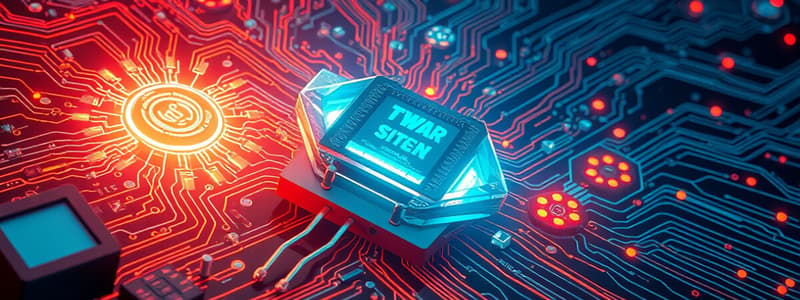Podcast
Questions and Answers
What characteristic distinguishes a Bipolar Junction Transistor from a Field-Effect Transistor?
What characteristic distinguishes a Bipolar Junction Transistor from a Field-Effect Transistor?
- Thermal Stability
- Transconductance (gm)
- Current Gain (β) (correct)
- Operating Regions
In which operating region is a transistor used primarily for amplification?
In which operating region is a transistor used primarily for amplification?
- Sub-threshold Region
- Active Region (correct)
- Saturation Region
- Cut-off Region
Which application of transistors is primarily related to their ability to switch electronic signals quickly?
Which application of transistors is primarily related to their ability to switch electronic signals quickly?
- Power Regulation
- Signal Modulation
- Amplification
- Computing (correct)
What is the significance of input and output impedance in BJTs compared to FETs?
What is the significance of input and output impedance in BJTs compared to FETs?
Which transistor characteristic is crucial for performance measurement in FETs?
Which transistor characteristic is crucial for performance measurement in FETs?
Flashcards are hidden until you start studying
Study Notes
Transistor Characteristics
- Definition: A transistor is a semiconductor device used to amplify or switch electronic signals.
- Types:
- Bipolar Junction Transistor (BJT)
- Field-Effect Transistor (FET)
- Key Characteristics:
- Current Gain (β): Ratio of output current to input current in BJTs.
- Transconductance (gm): Measure of the performance of a FET; change in output current per change in gate-source voltage.
- Input and Output Impedance:
- BJTs have lower input impedance compared to FETs.
- FETs typically exhibit high input impedance.
- Switching Speed: Speed at which a transistor can turn on and off; important in digital circuits.
- Thermal Stability: Transistors can be affected by temperature, which can impact their performance and reliability.
- Operating Regions:
- Active Region (for amplification)
- Cut-off Region (for off state)
- Saturation Region (for on state)
Applications Of Transistors
- Amplification: Used in audio equipment, radios, and televisions to boost signal strength.
- Switching: Essential in digital circuits, microprocessors, and logic gates for turning signals on and off.
- Oscillators: Employed in generating sine waves and clock signals for various applications.
- Signal Modulation: Used in communication systems for modulating signals in radio frequency (RF) applications.
- Power Regulation: Utilized in voltage regulators to maintain a constant output voltage.
- Computing: Fundamental building blocks of integrated circuits (ICs) and microchips in computers and smartphones.
- Sensors: Incorporated in various sensor technologies, including temperature and pressure sensors.
Transistor Characteristics
- A transistor amplifies or switches electronic signals using semiconductor materials.
- Main types of transistors include Bipolar Junction Transistor (BJT) and Field-Effect Transistor (FET).
- Current Gain (β) is crucial for BJTs, indicating the amplification capacity as the output current per input current ratio.
- Transconductance (gm) measures a FET's ability, reflecting how much the output current changes with variations in gate-source voltage.
- BJTs typically have lower input impedance compared to FETs, which often display significantly high input impedance.
- Switching speed highlights how quickly a transistor can toggle between states, vital for digital circuit performance.
- Thermal stability is key; temperature fluctuations can severely affect a transistor's performance and reliability.
- Three main operating regions:
- Active Region: Enables amplification.
- Cut-off Region: Represents the transistor in the off state.
- Saturation Region: Indicates the transistor in the fully on state.
Applications of Transistors
- Transistors amplify signals in audio devices, radios, and televisions.
- They serve an essential role in digital circuits and microprocessors for switching operations.
- Act as oscillators to generate sine waves and clock signals for various technologies.
- Utilize signal modulation in communication systems for radio frequency applications.
- Employed in voltage regulators, transistors help maintain consistent output voltage levels.
- Central to computing, they form the foundational elements of integrated circuits (ICs) and microchips in computers and smartphones.
- Transistors are integral to sensors, including temperature and pressure sensing technologies.
Studying That Suits You
Use AI to generate personalized quizzes and flashcards to suit your learning preferences.




